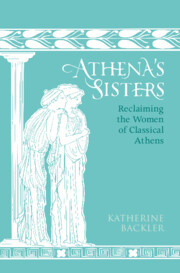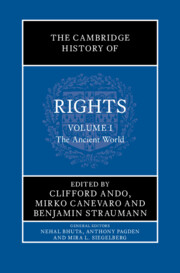Refine search
Actions for selected content:
24162 results in Ancient history

Athena's Sisters
- Reclaiming the Women of Classical Athens
- Coming soon
-
- Expected online publication date:
- January 2026
- Print publication:
- 12 February 2026
-
- Book
- Export citation

The Cambridge History of Rights
- Coming soon
-
- Expected online publication date:
- January 2026
- Print publication:
- 27 November 2025
-
- Book
- Export citation
Chapter 2 - The Cultural Ecosystem of Late Antique Gaul
-
- Book:
- Learning and Power in Late Antique Gaul
- Published online:
- 22 December 2025
- Print publication:
- 22 January 2026, pp 50-89
-
- Chapter
- Export citation
Chapter 1 - Classical Education in the Late Roman World
-
- Book:
- Learning and Power in Late Antique Gaul
- Published online:
- 22 December 2025
- Print publication:
- 22 January 2026, pp 23-49
-
- Chapter
- Export citation

The Topography and Monuments of Ancient Rome
- Coming soon
-
- Expected online publication date:
- January 2026
- Print publication:
- 31 January 2026
-
- Book
- Export citation
Index Locorum
-
- Book:
- Learning and Power in Late Antique Gaul
- Published online:
- 22 December 2025
- Print publication:
- 22 January 2026, pp 269-272
-
- Chapter
- Export citation
Appendix 1: - Prosopography of Teachers and Students in Late Antique Gaul
-
- Book:
- Learning and Power in Late Antique Gaul
- Published online:
- 22 December 2025
- Print publication:
- 22 January 2026, pp 202-230
-
- Chapter
- Export citation
Abbreviations
-
- Book:
- Learning and Power in Late Antique Gaul
- Published online:
- 22 December 2025
- Print publication:
- 22 January 2026, pp ix-x
-
- Chapter
- Export citation
Chapter 5 - Classical Education and Church Schools
-
- Book:
- Learning and Power in Late Antique Gaul
- Published online:
- 22 December 2025
- Print publication:
- 22 January 2026, pp 161-196
-
- Chapter
- Export citation
Appendix 2: - CTh 13.3.11 – Gratian’s ‘School Edict’
-
- Book:
- Learning and Power in Late Antique Gaul
- Published online:
- 22 December 2025
- Print publication:
- 22 January 2026, pp 231-232
-
- Chapter
- Export citation
Conclusion
-
- Book:
- Learning and Power in Late Antique Gaul
- Published online:
- 22 December 2025
- Print publication:
- 22 January 2026, pp 197-201
-
- Chapter
- Export citation
Bibliography
-
- Book:
- Learning and Power in Late Antique Gaul
- Published online:
- 22 December 2025
- Print publication:
- 22 January 2026, pp 233-268
-
- Chapter
- Export citation
Chapter 4 - Education in Society and Culture
-
- Book:
- Learning and Power in Late Antique Gaul
- Published online:
- 22 December 2025
- Print publication:
- 22 January 2026, pp 132-160
-
- Chapter
- Export citation
General Index
-
- Book:
- Learning and Power in Late Antique Gaul
- Published online:
- 22 December 2025
- Print publication:
- 22 January 2026, pp 273-277
-
- Chapter
- Export citation
Chapter 3 - The Relationship between Education and Power
-
- Book:
- Learning and Power in Late Antique Gaul
- Published online:
- 22 December 2025
- Print publication:
- 22 January 2026, pp 90-131
-
- Chapter
- Export citation
Acknowledgements
-
- Book:
- Learning and Power in Late Antique Gaul
- Published online:
- 22 December 2025
- Print publication:
- 22 January 2026, pp vii-viii
-
- Chapter
- Export citation
Contents
-
- Book:
- Learning and Power in Late Antique Gaul
- Published online:
- 22 December 2025
- Print publication:
- 22 January 2026, pp v-vi
-
- Chapter
- Export citation
Copyright page
-
- Book:
- Learning and Power in Late Antique Gaul
- Published online:
- 22 December 2025
- Print publication:
- 22 January 2026, pp iv-iv
-
- Chapter
- Export citation
Introduction
-
- Book:
- Learning and Power in Late Antique Gaul
- Published online:
- 22 December 2025
- Print publication:
- 22 January 2026, pp 1-22
-
- Chapter
- Export citation

Premodern Economies
- A Global Perspective
- Coming soon
-
- Expected online publication date:
- January 2026
- Print publication:
- 31 January 2026
-
- Book
- Export citation
